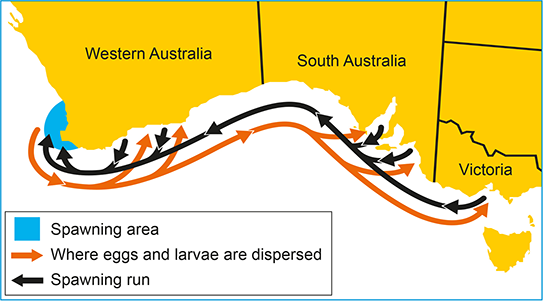In 2013, scientists from the Department of Fisheries (now Department of Primary Industries and Regional Development) revealed that a combination of environmental factors and fishing pressure had diminished the Australian herring (Arripis georgianus) stock in southern Australian waters.
This independently reviewed assessment considered:
catch composition
trends in
catch rates and recruitment (addition of young fish to a population)
vulnerability of the stock to depletion due to biological characteristics such as growth rate and
fecundity (potential reproductive capacity).
Environmental factors including a steady rise in ocean temperatures and unusual flow patterns in the Leeuwin Current are thought to have contributed to the drop in herring recruitment.
After herring management changes in 2015, an interim assessment in 2017 identified that the stock was recovering but had not yet reached target levels. The most recent stock assessment in 2021 indicates that management arrangements and favourable environmental conditions have supported the recovery of the Australian herring stock in Western Australia.
Read the 2022 science update about Australian herring.
Herring life cycle
While Australian herring are part of a single stock that stretches from the west coast of Western Australia along our south coast to South Australia and into Victoria, WA waters have a special part to play in the herring life cycle. This is because adult herring, which spawn from late May to early June, are only known to spawn on WA’s lower west coast, and mainly in the metropolitan area and south to Geographe Bay.
In years when the south-flowing Leeuwin Current (which transports warm tropical water south along the WA coast) is strong, eggs and larvae are carried from WA’s lower west coast all along the south coast, and as far east as Victoria. But in years of a weak current, more eggs and larvae stay on WA’s west coast. Herring stay wherever they settle until reaching maturity, when they migrate along the south coast back to our west coast to spawn. The herring then stay on WA’s west coast – there is no return migration. Preliminary science suggests that recruitment of herring is correlated with both spawning stock and environmental conditions (Leeuwin Current strength and sea surface temperature), indicating that they may be a species to benefit from climate change.

In some years a strong Leeuwin Current carries most herring eggs and larvae south and as far east as Victoria. On reaching maturity, the herring migrate back to WA's lower west coast to spawn. The herring then remain on WA's west coast – there is no return migration eastward.
Each year our researchers examine hundreds of fish skeletons donated by fishers to obtain information about the herring population, including its age structure (the number of fish of different ages).
The 2013 assessment revealed that just two adult age classes – 2 and 3 years old – formed most of the population. For a healthy population, there need to be more fish in the older age classes.
In 2019, a larger proportion of older fish between 3 and 5 years old were detected, indicating that the health of the stock had improved.
Herring can live for 12 years but most caught are aged 1-4 years. As herring mature sexually at 2-3 years, most are caught before they spawn or after only breeding once. So just two or three consecutive years of recruitment failure can create a serious problem.